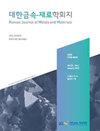马氏体不锈钢板的组织、拉伸和疲劳性能研究
IF 1.1
4区 材料科学
Q4 MATERIALS SCIENCE, MULTIDISCIPLINARY
引用次数: 0
摘要
研究了厚度为0.152 mm的马氏体不锈钢(MSS)板的显微组织、拉伸和疲劳性能。利用电子背散射衍射显微镜对其微观结构进行了初步研究。在初始冷轧MSS板后,在显微组织中观察到高位错密度,以及由极形显示的轧制织构。在轧制和横向上进行拉伸试验,比较材料在两个方向上的强度。结果表明:轧制方向拉伸强度较低;这可以归因于材料沿该方向的微观结构和晶体取向。在轧制方向的工作温度范围内,在不同温度下进行了额外的拉伸试验。结果表明,在室温下合金的拉伸强度和弹性模量最高。进行了高周疲劳试验,确定了MSS板的疲劳极限。在同一应力范围内控制疲劳循环次数,对合金的微观组织进行了分析。结果表明,晶粒内累积变形与疲劳循环次数成正比关系。这有助于理解MSS板的疲劳损伤机理。本文章由计算机程序翻译,如有差异,请以英文原文为准。
A Study on the Microstructure, Tensile and Fatigue Properties of Martensitic Stainless Steel Plate
The microstructure, tensile and fatigue properties of a martensitic stainless steel (MSS) plate with a thickness of 0.152 mm are investigated in this study. The microstructural properties were initially studied using electron backscatter diffraction microscopy. High dislocation densities were observed in the microstructure, along with the rolling texture revealed by the pole figure, following an initial cold rolling process of the as-received MSS plate. Tensile tests were conducted in both the rolling and transverse directions to compare the strength of the material in both directions. The results showed that the tensile strength was relatively low in the rolling direction. This can be attributed to the microstructure and crystallographic orientation of the material along that direction. Additional tensile tests were performed at various temperatures within the operating temperature range in the rolling direction. The results indicate that the highest tensile strength and elastic modulus are observed at room temperature. A high-cycle fatigue test was performed to determine the fatigue limit of the MSS plate. Furthermore, the microstructure was analyzed by controlling the fatigue cycles within the same stress range. The results revealed a proportional relationship between the accumulated deformation within the grains and the fatigue cycles. This can be helpful in understanding the fatigue damage mechanisms of the MSS plate.
求助全文
通过发布文献求助,成功后即可免费获取论文全文。
去求助
来源期刊

Korean Journal of Metals and Materials
MATERIALS SCIENCE, MULTIDISCIPLINARY-METALLURGY & METALLURGICAL ENGINEERING
CiteScore
1.80
自引率
58.30%
发文量
100
审稿时长
4-8 weeks
期刊介绍:
The Korean Journal of Metals and Materials is a representative Korean-language journal of the Korean Institute of Metals and Materials (KIM); it publishes domestic and foreign academic papers related to metals and materials, in abroad range of fields from metals and materials to nano-materials, biomaterials, functional materials, energy materials, and new materials, and its official ISO designation is Korean J. Met. Mater.
 求助内容:
求助内容: 应助结果提醒方式:
应助结果提醒方式:


